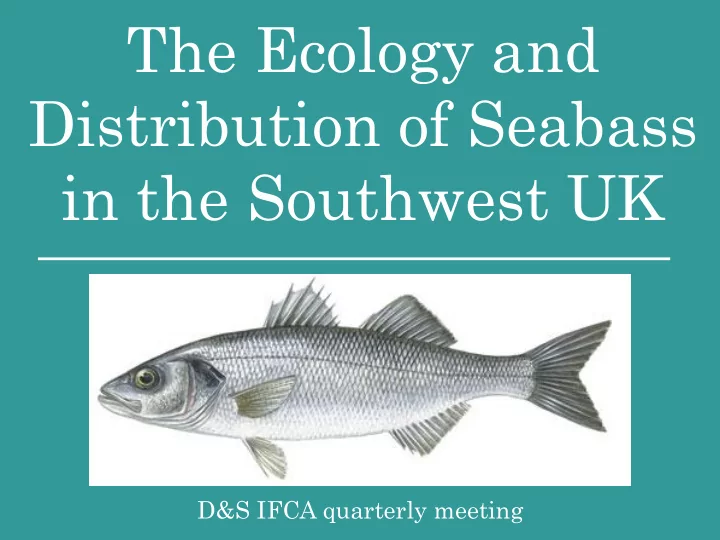

The Ecology and Distribution of Seabass in the Southwest UK D&S IFCA quarterly meeting
The Ecology and Distribution of Seabass in the Southwest UK Sup uperv ervisory sory Team am Na Name Organisa anisation tion Dr Emma Sheehan Plymouth University Dr Elizabeth West D&S IFCA Tim Robbins D&S IFCA Dr Shaun Plenty Teleost Consulting Prof Martin Attrill Plymouth University
PhD Context
Stock Status With 0 commercial catch in 2017, the North Atlantic stock is predicted to remain below “ Blim ” in 2018 (ICES, 2016) PhD: The Ecology and Distribution of Seabass in the Southwest UK
Dependence on estuaries Spawning aggregations Site fidelity Dependence on estuaries PhD: The Ecology and Distribution of Seabass in the Southwest UK
Regional management Estuaries: • Highly important ecosystem for European Seabass • Nursery ground • Feeding opportunities Review: • Existing management of European Seabass within and adjacent to estuaries • Identify specific habitats or “features” important for seabass PhD: The Ecology and Distribution of Seabass in the Southwest UK
Managed Re-alignment fish survey • 85% of UK estuaries adapted by land reclamation • 25-80% loss in intertidal habitat • Estuaries in “Bad and deteriorating” Conservation Status – EC habitats directive • Saltmarsh in “unfavourable status” – EC habitats directive
Steart Marsh, Severn Estuary
Managed Re-alignment Fish Survey Overall Question: • Do Managed Re-alignment schemes provide equivalent habitat to natural saltmarsh • Testing for differences between: • Fish community • Diet & feeding success Steart Marsh PhD: The Ecology and Distribution of Seabass in the Southwest UK
Managed Re-alignment Fish Survey Survey Plan: • 3 Managed Re-alignment schemes plus natural saltmarsh PhD: The Ecology and Distribution of Seabass in the Southwest UK
Managed Re-alignment Fish Survey a – Fyke net a – Fyke net Method: • Deploy fyke (a) and seine (b) nets in Managed Re- alignment and adjacent natural saltmarsh b – Seine net PhD: The Ecology and Distribution of Seabass in the Southwest UK
Managed Re-alignment Fish Survey • Five surveys completed • 16 species - nine of commercial interest: Seabass; Herring; Flounder; Plaice; Sprat Whiting Mullet (3 species) • European Eel of Conservation interest Pictures taken at Steart Marsh, Severn Estuary PhD: The Ecology and Distribution of Seabass in the Southwest UK
Managed Re-alignment Fish Survey Fish Community • Different fish community captured within Managed Re- alignment than in natural saltmarsh • Average diversity higher within Managed Re-alignment Schemes than natural saltmarsh PhD: The Ecology and Distribution of Seabass in the Southwest UK
Managed Re-alignment Fish Survey Diet: 0+ Seabass • MDS plot suggests some grouping of 0+ European Bass diet • 1+ Seabass, TLM and Gobies captured however not analysed to date Sample Size - * sample site removed Survey Sample Site Treatment n BBSSSI Natural 12 HNR* Natural 1 Steart Marsh SM MRAS 18 JM MRAS 8 Wallasea Island PCN Natural 13 PCS Natural 27 PhD: The Ecology and Distribution of Seabass in the Southwest UK
Managed Re-alignment Fish Survey PhD: The Ecology and Distribution of Seabass in the Southwest UK
Managed Re-alignment Fish Survey Summary • MRAS do provide habitat for fish: • High fish diversity • Habitat not currently equivalent to natural saltmarsh: • Different diet • Continue monitoring PhD: The Ecology and Distribution of Seabass in the Southwest UK
Tracking bass within and adjacent to Estuaries • Assess the effectiveness of designated Bass Nursery Areas • Monitor movement with other fish species
Tracking IBASS - Immature Bass Acoustic Stock Surveillance • EMFF funding - £249,000.00 • Track juvenile European seabass movement through acoustic telemetry • 84 Receivers • 150 transmitter tags PhD: The Ecology and Distribution of Seabass in the Southwest UK
Tracking IBASS - Immature Bass Acoustic Stock Surveillance Aim – Monitor movement across BNA boundary: 1) Identify the frequency of movement outside BNA boundary 2) Help inform BNA demarcation or netting practices in close proximity PhD: The Ecology and Distribution of Seabass in the Southwest UK
Tracking IBASS - Immature Bass Acoustic Stock Surveillance Aim - Monitor movement patterns within BNA: 1) Track overall movement 2) Correlate movement to environmental variables 3) Identify broad areas of interest for “active tracking” surveys PhD: The Ecology and Distribution of Seabass in the Southwest UK
Tracking Assessing competitive interactions between European Seabass and Gilthead Seabream • Salcombe Harbour – Ria system • 50 European seabass, • 25 Gilthead seabream • Gilthead seabream ( Sparus aurata ) • “Recent” colonisation of the south UK • High commercial value • Exploit similar habitats to European seabass PhD: The Ecology and Distribution of Seabass in the Southwest UK
Tracking Assessing spatial overlap between commercial target and non target fish species • Taw/Torridge and Dart estuaries • 2 Estuaries • 100 European Seabass • 40 Sea trout (Salmo trutta) • Sea trout; • Very little information on estuarine movement, • Potential by-catch species with high recreational value PhD: The Ecology and Distribution of Seabass in the Southwest UK
Static netting review
Static netting review • D&S IFCA netting permit bylaw Headline depth • Fixed net headline depth of 3m within “coastal areas” • Migratory salmonids associated to shallow (0-5m) water depth (Summer, 2015) • EA suggested headline depth of Headline depth Reason 5m 0m Control • Limited supporting evidence Current headline 3m and could reduce catch from depth net fisheries Experimental 5m headline depth PhD: The Ecology and Distribution of Seabass in the Southwest UK
Static netting review • D&S IFCA netting permit bylaw • Fixed net headline depth of 3m within “coastal areas” • Migratory salmonids associated to shallow (0-5m) water depth (Summer, 2015) • EA suggested headline depth of Headline depth Reason 5m 0m Control • Limited supporting evidence Current headline 3m and could reduce catch from depth net fisheries Experimental 5m headline depth PhD: The Ecology and Distribution of Seabass in the Southwest UK
Fin . . . . Comments and suggestions welcome!! Thomas.stamp@plymouth.ac.uk
Recommend
More recommend